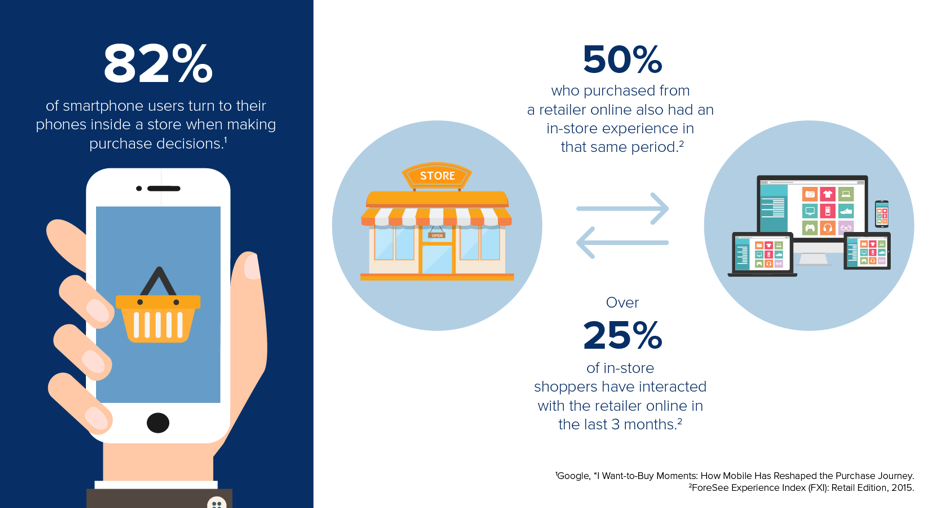What’s better: shopping online or in-person? Short answer: yes. We’re in a new type of era where the spheres between online and off are blurry, interconnected, and strengthen one another. We’re all trying to meet the consumer where they are. If they can interact in both spaces indiscriminately, shouldn’t your brand?
“Phygital” is the concept of using technology to bridge the digital world with the physical world with the purpose of providing a unique interactive experience for the user. While the buzzword is relatively new (and awful), many of the technologies required to fuse a digital and physical experience have been around since the 90s.
Augmented Reality, now talked about as a “new” immersive experience, dates back to the Virtual Fixtures system developed at the U.S. Air Force’s Armstrong Laboratory in 1992. As early as 2015, a Microsoft Digital Trends report found that nearly 50% of consumers were more likely to engage with digital experiences that offered seamless integration with their physical world – signaling a shift in how consumers expect the physical and digital worlds to blend. The real trick has been combining this preexisting technology with an experience that people actually want to have.
According to the IAB Spain 2018 e-commerce study, at least seven out of every ten internet users buy online. Despite this near-ubiquity, 22% of users still miss the physical interaction, so they will end up browsing online and then make their purchase in a brick-and-mortar retailer.

This is why, despite reports of Amazon killing off independent bookstores, they have grown for a second straight year. This is also why many people go into a bookstore to see, touch, and read part of a book – then buy it online.
Phygital marries both the online and offline environments by trying to take the best aspects from each space to create a much more complete and satisfying customer experience. The user browses and buys, but they also feel. And that’s the real kicker.
As beautifully outlined by Jose Maria Machuca for we are marketing, phygital takes the best components from the digital retail experience like immediacy, immersion, and interaction to satisfy a consumer that is demanding, hyper-connected, and is looking to meet their needs through multiple platforms.
- Immediacy: works to ensure things happen at an exact moment in time
- Immersion: the user is part of the experience.
- Interaction: generation of communication which is needed to activate the more physical and emotional part of the purchasing process.
“Consumers today are looking for a holistic and seamless experience that is curated specifically for them and not mass produced,” says Harshavardhan Chauhan, Head of Marketing at DLF Shopping Malls. “Hence, there is a need to build a 360-degree approach where the online medium plays an important role in initiating a captivating conversation that is further enhanced through differentiated and personalized offers and finally leads to a seamless offline experience.”
Humble Hardware Store Goes High-Tech
So, what does this look like in the real world? One example is Lowe’s OSHbots, an autonomous retail service robot designed to amplify the shopping experience for customers. Customers can tell the bot what they’re looking for or just hold up an item for it to scan, and then the 5-foot-tall robot navigates you there. The bot also helps store employees with tasks like inventory scanning and the ability to speak in English, Spanish, and five different Asian languages. The robots don’t replace the workers, they merely free them up from menial tasks to assist with things technology can’t replicate like empathy, storytelling, and forming a personal connection.
A Grocery Store with No Check Out, No Lines
Amazon Go is another example of a brick-and-mortar moving with the agility of an online shop. In these supermarkets, a customer scans a code with their smartphone, picks up the products they desire, and then leaves the store without passing through the traditional checkout line. Instead, they’ll get an electronic receipt detailing the amount Amazon will charge to their account. So, instead of wasting your labor force on scanning barcodes, they can be walking around, making recommendations, or demoing new products.
If Amazon already has a service where you can drone groceries straight to your house, why invest in brick-and-mortar? Because the future isn’t a straight line, speed isn’t everything, and the goal of technology should be finding more ways to bring us together, not isolate us in frictionless cells.
The Future of Fashion
Rebecca Minkoff is using technology in some of its retail stores to transform their customers’ experience. Shoppers can choose the items they want to try on by using touchscreens placed throughout the store. When they’re ready, they’ll get a message on their phone with the fitting room number, where they’ll find all the items they requested. But what happens if they need a bigger size? Every fitting room has a screen where they can request another size without having to look for it on the floor on their own or have to ask a Sales Associate to bring it. Customers leave happy – and also leave behind a trail of super valuable data: everything they like and what they are pairing it with.
Smart Businesses Can’t Run on Dumb Terminals
Even if you can’t afford to build a robot for your business, you can at least start to swap out the legacy technology keeping you in the dark ages. Smart terminal systems like Poynt, Clover, and Square are changing the game by turning the traditional point-of-sales into a digital platform for connecting with their customers, downloading apps, and growing their digital business. What was once a simple cash machine can drive customer loyalty or even keep your taxes in order.
What opportunities in your customer journey could be enhanced by the immediacy of a digital experience? What aspects of your online strategy could be bolstered by the interaction and emotional connection of a physical experience? How can we leverage technology to free people up to do what they do best: be people?
Phygital won’t replace brick-and-mortar. It’s about creating more efficient and ultimately more human interactions.
Emotive Brand is a brand strategy and design agency in Oakland, California.





